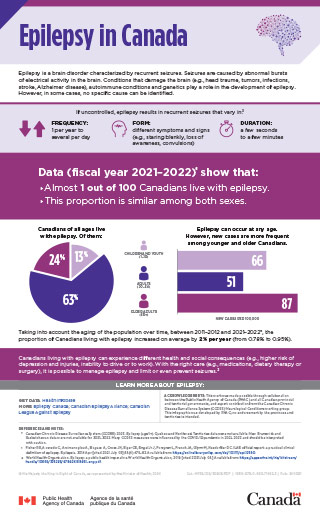Epilepsy in Canada

Download the alternative format
(PDF format, 189 Kb, 1 page)
- Organization: Public Health Agency of Canada
- Date published: May 2024
Epilepsy is a brain disorder characterized by recurrent seizures. Seizures are caused by abnormal bursts of electrical activity in the brain. Conditions that damage the brain (e.g., head trauma, tumors, infections, stroke, Alzheimer disease), autoimmune conditions and genetics play a role in the development of epilepsy. However, in some cases, no specific cause can be identified.
If uncontrolled, epilepsy results in recurrent seizures that vary in:Footnote 1
Frequency: 1 per year to several per day
Form: different symptoms and signs (e.g., staring blankly, loss of awareness, convulsions)
Duration: a few seconds to a few minutes
Data (fiscal year 2021–2022)Footnote *show that:
- Almost 1 out of 100 Canadians live with epilepsy.
- This proportion is similar among both sexes.
Canadians of all ages live with epilepsy. Of them:
- 13% were children and youth (aged 1 to 19 years)
- 63% were adults (aged 20 to 64 years)
- 24% were older adults (aged 65 and older)
Epilepsy can occur at any age. However, new cases are more frequent among younger and older Canadians.
- 66 new cases per 100,000 in children and youth (aged 1 to 19 years)
- 51 new cases per 100,000 in adults (aged 20 to 64 years)
- 87 new cases per 100,000 in older adults (aged 65 and older)
Taking into account the aging of the population over time, between 2011-2012 and 2021-2022Footnote *, the proportion of Canadians living with epilepsy increased on average by 2% per year (from 0.78% to 0.95%).
Canadians living with epilepsy can experience different health and social consequences (e.g., higher risk of depression and injuries, inability to drive or to work). With the right care (e.g., medications, dietary therapy or surgery), it is possible to manage epilepsy and limit or even prevent seizures.Footnote 2
Learn more about epilepsy
- Get data Health Infobase
- More
Acknowledgements
This work was made possible through collaboration between the Public Health Agency of Canada (PHAC) and all Canadian provincial and territorial governments, and expert contribution from the Canadian Chronic Disease Surveillance System (CCDSS) Neurological Conditions working group. This infographic was developed by PHAC; no endorsement by the provinces and territories is intended.